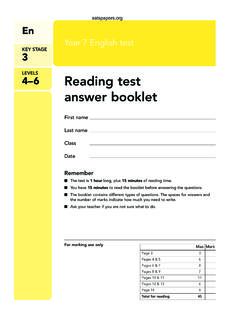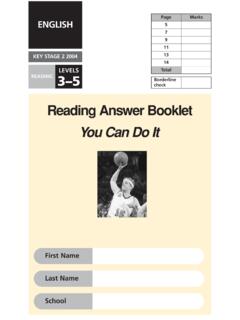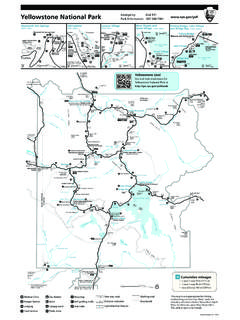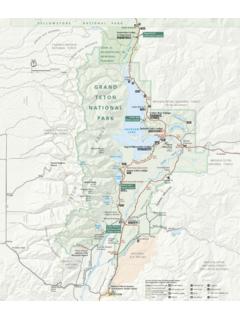Transcription of Key stage 2 English reading - SATs papers
1 KEY stage . 2. July 2014. Key stage 2 English reading national curriculum assessments Sample questions, mark schemes and commentary for 2016 assessments Introduction to sample materials The new national curriculum will be assessed for the first time in May 2016. This set of sample materials is being published to give teachers an indication of how the new curriculum will be assessed. The materials presented here primarily focus on new areas of the curriculum and how questions assessing those areas might appear. The examples in this document have not been through the rigorous development process that live tests go through. We will decide on final question formats once we have data from trialling the test materials.
2 This means that some of the question types may not appear in the live tests. We will publish complete sample tests in 2015 that will reflect our findings and will be indicative of the final live tests. These materials have been reviewed by teachers and their comments have been taken into account. As the questions have not been trialled in schools, the mark schemes do not consider the full range of acceptable responses or include example pupil responses. They only give a basic indication of the types of response that would be credited. The questions in the English grammar, punctuation and spelling, mathematics and science tests will appear in order of difficulty, where possible.
3 In English reading , the texts appear in order of difficulty. In these sample materials, the texts and questions are not necessarily in order of difficulty, nor do they reflect the range of question difficulties that will appear in the final tests. Test frameworks that illustrate the test model, content domain and performance descriptors for the 2016 national curriculum tests are on at Please note that these sample materials are not designed to match the frameworks in terms of ratios of question/item type or coverage. They do not form complete tests as described by the test frameworks and are, therefore, not sample tests. We recommend that these materials are not used for assessment purposes.
4 Page 1 of 19. Key features of the English reading tests The questions in the English reading tests will be linked to a specific area of the national curriculum. These areas are listed in the test frameworks. Tests could include age-appropriate fiction, non-fiction and poetry from a variety of origins and traditions, covering, over time, a wide range of text types, forms and purposes. The final texts in the test booklets will be more demanding than current texts for both key stage 1 and key stage 2. Questions written for the reading test will clearly depend on the texts that are selected. There is a focus on comprehension in the new national curriculum and there will therefore be a higher percentage of comprehension questions in the new assessments.
5 national curriculum assessments The key stage 2 test will contain three / four texts. The texts will become more difficult as you go through the paper; they won't be linked by a theme. The reading booklet will be separate from the answer booklet. The text and questions are presented together here, but they will be separate in the live test. Vocabulary in context will be explicitly assessed. Pupils will need to identify or provide their own synonyms for specific words within the texts. Pupils will need to demonstrate an understanding of texts by predicting what might happen next. Prediction questions will mainly be limited to fiction, or where information, plot or character development allows.
6 Answers will need to be text based. Pupils will need to refer to key elements of plot, character or information. This document does not include sample prediction questions as the sample text does not lend itself to this question type. There will be questions where pupils need to demonstrate an understanding of the differences between fact and opinion. These will mainly be associated with non-fiction texts. Comparison is now an explicit area of the national curriculum. Pupils will need to compare information, characters or events within a text. Summary is also a new expectation of the national curriculum. Summary questions will usually be closed questions.
7 Pupils will need to order events from fiction or non-fiction texts, or select the most appropriate summary from a given list. Pupils' answers to open response summary questions will need to be securely rooted in the text. Timings for the test The English reading paper will take an hour to administer. There will be no separate reading time. Page 2 of 19. Children's Geographic exploring national Parks Many countries all over the world have Are there national Parks national Parks. There are about 7000 national in England? Parks throughout the world. Most of them There are nine national Parks in England. The protect natural settings as well as the plants first three were the Peak District, the Lake and animals that live there, but a few are in District and Dartmoor, which were all named towns and cities.
8 As national Parks in 1951. Others followed soon The United States of America created the very afterwards: the North York Moors in 1952, the first one, Yellowstone national park , in 1872. Yorkshire Dales and Exmoor in 1954 and in 1956. It is so big that it covers part of three states: Northumberland. No new ones were added for Wyoming, Montana and Idaho. People go there nearly 50 years. The final two, the New Forest and to see the geysers (natural hot springs) and the South Downs, were designated as national amazing rock formations. The most famous Parks in 2005 and 2010 respectively. The Norfolk geyser, Old Faithful', erupts about 20 times a day.
9 Broads was given similar status to the parks in The largest national park in the world 1989, so it is generally included in information is in Northeast Greenland. The park about them. is so vast that only 30 countries Are national Parks in in the world are larger. England the same as those Map showing the national Parks of the in other countries? United Kingdom. Many national Parks around the world cover huge areas of land where nobody lives, but in England most of the countryside within them is used for farming and other activities. As a result, national Parks in England include places where people live and work, as well as wild and beautiful areas where there is little sign of human life.
10 The national Parks in England are often called England's Breathing Spaces' because they are places where people can go to be in the open air, away from the dirt and noise of cities and towns. They provide spectacular scenes of mountains, meadows, moorlands, woods and wetlands. Page 3 of 19. national curriculum assessments visitors. This results in overcrowded car parks and roads choked with traffic. Life can be difficult for people who live there, as gift shops and cafes take over from everyday shops; in popular areas, house prices can become too expensive for local people making it hard for them to stay in the area. Why go to the national Parks?















